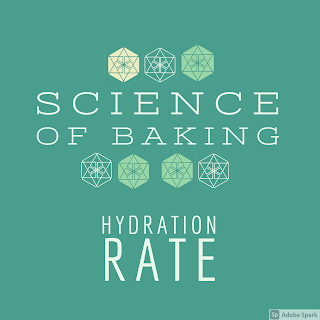Importance of Hydration Rate
Hydration Rate is the amount of water in recipe compare to the amount of flour, for example if you have 1000 grams flour and 500 grams water you have 50% hydration rate. You can compute your hydration rate in your recipe using baker’s percentage. Hydration rate depend on the recipe, the more water the better at a certain point like for example for sourdough and ciabatta, but having more hydration rate at soft breads will be bad for your recipe. Sometime it also depends on the consistency you need and how you can handle the hydration rate on your dough as long it is manageable. If your recipe has another dry ingredients (milk powder, multi grain, rye flour etc) you need to add hydration. Water is responsible for all the natural chemical reactions happening. The two important are enzyme activity fermentation activity. Temperature of water affects on the final dough, cold water generate cooler dough which will slow down your proofing unlike in warm water
UNDER ABSORPTION | |
DOUGH | FINISHED PRODUCT |
Stiff and dry Not enough water to hydrate Final development cannot occur Slower proofing Inadequate pan flow | Low volume Dense and firm internal structure Stales more quickly White corner edges |
OVER ABSORPTION | |
DOUGH | FINISHED PRODUCT |
Wet and sticky Extended clean up time Prone to over fermentation Hard to manage dough | Poor symmetry Large volume open crumb grain with large cell( air pocket) prone to mold |
HYDRATION RATE | DOUGH TEXTURE | BREAD TYPE AND CRUMBS |
50-57% | Stiff, very firm, dry and satiny, not tacky | Yield dense crumb in bagels and pretzels Bagels(50-57%) are one of the least hydrated dough and extremely stiff. This means they need a ton of kneading to get all the flour incorporated and gluten development, it also means that they are not sticky at all in dough form |
58-65% | Standard tacky but not sticky, supple | Yields dense, closed crumbs Many formulas like white sandwich, French bread and challah use around 57-65% hydration. The dough starts to be more tacky, but more extensible. These dough can hold their shape well , but also for greater volume in proofing |
65-80% | Rustic, wet sticky | Yields an airy crumb and large, irregular holes, in breads like ciabbata, focaccia and pizza On the higher end spectrum you have breads like focaccia and ciabatta, which could be 65-80% hydrated. These dough are extremely sticky. Kneading does not need on this dough, instead techniques like folding or autolyze method |
NOTE: different types of flour absorb water differently because of their gluten protein percent. You may need to adjust dough consistency ( source craftybaking.com)
HOW DOES ABSORPTION WORK?
When flour are mixed together , water molecules hydrate the gluten-forming proteins gliadin and glutenin, as well as damaged starch and other ingredients. The Hydration process is achieved when protein and starch molecules create hydrogen bonds and hydrophilic interactions with the water molecules.
Particles hydrate by rubbing against each other and contacting water. Process parameters such as type of mixers, beating arm, water flow and pressure remove the hydrated surface and expose a new layer of the particles to the excess water so the water diffusion process can continue. ( source bakerpedia)
IMPORTANCE OF WATER QUALITY
TASTE. Unusual bad taste or bad smell identified in the water could alter the final flavor of product.
CHEMICAL CONTENT. Chlorine is one chemical that will have noticeable effect in dough. It will affect the fermentation process of yeast since it is microorganism. High level of chlorine could affect some components of flour like enzymes. Slower enzymes activity will also affect the flow of water in dough.
MINERAL CONTENT. Mineral content will depend on hardness and softness of the water. Hard water contains large amount of minerals unlike soft water. Minerals use as nutrients for yeast. Hard water will provide faster fermentation and gives excess strength in dough.
FUNCTION
Loaf volume
Fracture stress of bread crumbs
Bread yield
Proofing
Machinability
Shelf life
INFLUENCING FACTORS OF WATER ABSORPTION
STARCH. 46% of water absorbed is associated with the starch.
PROTEINS. 31% of total water absorb is associated with proteins
PENTOSANS. 23% of water is associated with pentosans (barley like plants)
VITAL WHEAT GLUTEN.
*other water binding ingredients like fiber, eggs, bran and gums



Comments
Post a Comment